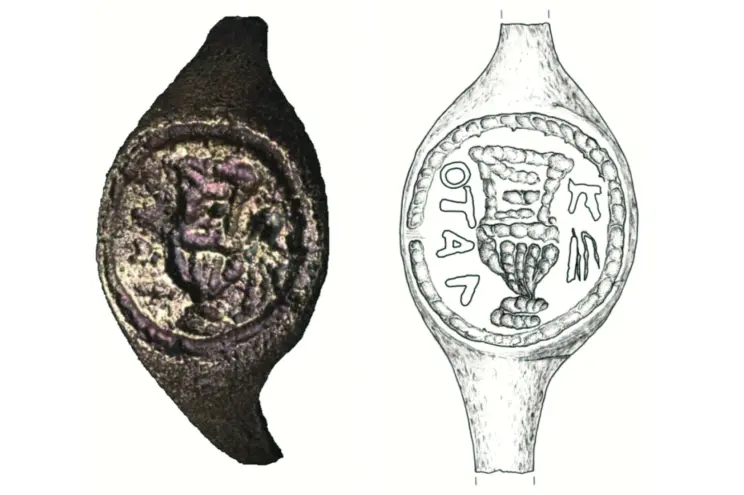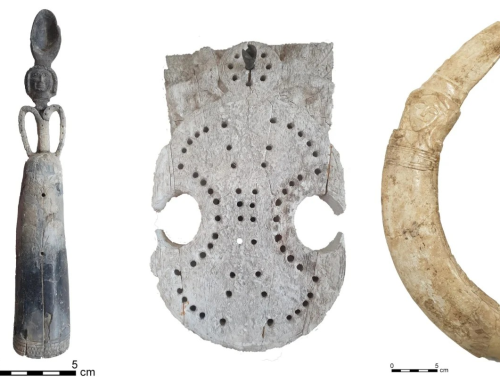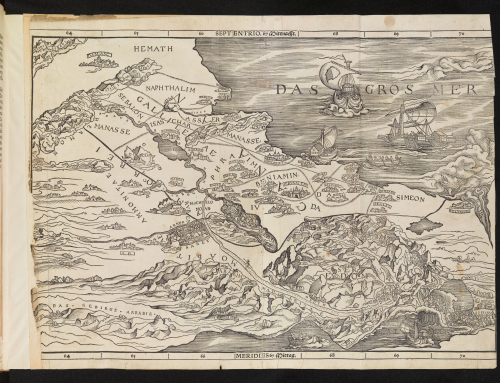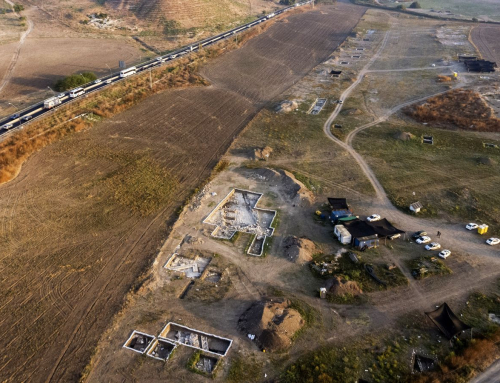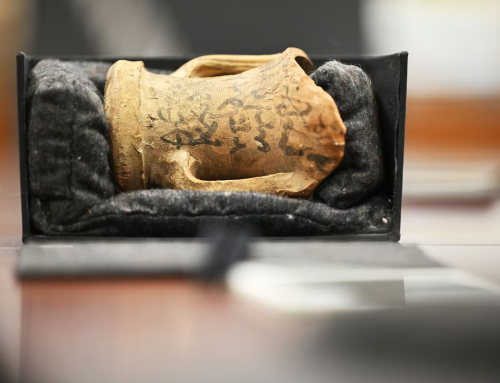For 2,000 years, a copper ring lay in the earth, passed out of all knowledge. Then its chance arrived, in the form of the archaeologist Gideon Forster excavating the ancient mountain palace called the Herodium in the Judean Desert, in the 1960s.
Actually, then the ring, a sealing ring, spent another 50 years lying quietly in the keeping of the Israel Antiquity Authority. But in 2018, scholars revisited it, deciphered the writing on the ring and deduced that it might have belonged to, or somehow been associated with, the alleged crucifier of Jesus – Pontius Pilate.
But now, a fresh examination and reading of the ring strongly suggests it might have had a very different master.
The item in question had been discovered while excavating a courtyard of the palace-fortress in 1968 – 1969, within the debris covering the portico. It was a simple cast-copper alloy finger ring and was dated between the first century B.C.E. to mid-first century C.E.
The image on the ring shows a krater (a clay pot) with Greek letters on either side: ПI (pi) on the right and ɅATO (lato) on the left. Leah Di Segni, an expert in Greek epigraphy suggested it should be read as one word: as PILATO.
In 2018 a team of scholars including Forster, who had found the ring, and Roi Porat, the current lead archaeologist at the Herodium ran an article based on the style of the ring and of the specific krater image, which had become a typical Jewish symbol of the time.
Their conclusion, based on the reading of Leah Di Segni of the inscription, its dating, the fact that it was found in Herodium, and its style and material was that even if it says “Pilate”, it probably did not belong to Pontius Pilatus himself, the mighty Prefect of Roman Judaea, the southern part of the province of Syria – it was too simple.
But it could plausibly have belonged to someone within his administration, perhaps a family member, or even a freed slave, they suggested. In its enthusiasm the international press missed the nuance, going for headlines such as “Pontius Pilate’s ring” even though that interpretation was only a suggestion and not a fait accompli.
Now two other experts, Prof. Werner Eck from the Ancient History Department at the University of Cologne, Germany and Dr. Avner Ecker from The Martin (Szusz) Department of Land of Israel Studies and Archaeology at Bar Ilan University present an alternative reading in the journal ‘Atiqot that proposes a different interpretation and a very different ringmaster.
The Herodium palace is actually a fortress constructed around 30 – 15 B.C.E. by King Herod the Great, also known as Herod the Builder, and named after him. It was positioned strategically on the border of Judea, Idumea, and the Judean Desert, 10 kilometers south of Jerusalem and 5 kilometers southeast of Bethlehem.
Once Herod had consolidated his rule in Judea, he established an alternative seat of power at the Herodium, allowing him to rule over Judea while simultaneously distancing himself from Jerusalem’s religious tensions and religious leadership, which, to put it mildly, had a strained relationship with the Roman client King Herod, Porat explains.
After Herod died, a few years into the new millennium, Judea came under direct Roman governance, with Roman prefects assuming control and using Herodium as one of their administrative centers. According to the Roman-Jewish historian Flavius Josephus, one of the most notorious was Pontius Pilate, who held authority over Judea from 26 to 36 CE.
As was often the case in the complex dynamics between local populations and Roman rule, their relationship status was complicated.
During the First Jewish Revolt against the Romans, Jewish rebels conquered the Herodium in 66 C.E. and maintained control until their defeat by the Romans in 71 C.E, after which a Roman garrison was stationed at the site.
Fifty years later, another Jewish revolt erupted: the Bar-Kokhba Revolt (132–136 CE), also known as the second Jewish Revolt. The Herodium was captured by the rebels once again, and again they used the hilltop fortress as a command post and administrative center. After Bar Kokhba’s defeat, the Herodium would lie abandoned for centuries – until the Late Roman and Byzantine period, when it would be used from the 4th to the 7th century C.E.
In short, you can summarize the Herodium history as mixed Roman and Jewish until the First Jewish revolt after which it turned out to be a ping pong match between the two.
Today, the local Arabs call the site Jabal al-Fureidis, meaning ‘”Mountain of the Little Paradise.” From its top, you can see the Judean desert and, on clear days, catch glimpses of Jerusalem and Bethlehem in the distance while admiring the craftsmanship of Herodian architecture.
And deep among the debris from the days of the Romans, along with coins and other archaeological finds, was the simple copper ring with Greek markings. The writing had deteriorated, leaving room for interpretation.
Considering that the ring was discovered within the archaeological layer associated with Roman rule and that Pilate is a rare name, and that no other people using the cognomen Pilatus are known in Judea at that time, the possibility that it might have been associated with Pilate in some capacity appears plausible, Porat suggests.
However, Eck and Ecker – experts in Roman history and epigraphy – maintain that even though Pilate ruled in Herodium, and even though coins from his period of rule have been unearthed there, the association with him is implausible.
Pontius Pilate held the esteemed rank of the equestrian class, a cavalryman, which was the second-highest property-based status in ancient Rome, positioned just below the senatorial class. “To draw a modern parallel, one could liken it to figures like the Kennedys,” Ecker says.
Historically, it’s known that the Equites flaunted signet rings as a status symbol, often bestowing them upon their subordinates or close ones, but those were gold rings, not low-quality copper rings. Moreover, why would it bear a Jewish-style krater on it, he says.
Secondly, during the period in question, even if coins (and this ring!) had Greek inscriptions, Roman officials used Latin as their administrative language. Greek would only be adopted as the dominant language in the empire’s East much later.
Last but not least is the matter of the name. Roman names comprised three components: the praenomen (given name), the nomen (family name or clan), and the cognomen.
In Pilate’s day, the cognomen was like a nickname, something personal, not something that would be bestowed onto another family member, let alone a slave. Therefore, even if Pilate bestowed a ring unto a slave or subordinate, that person’s name wouldn’t have had “Pilate” as its cognomen.
The entire thesis that the ring belonged to, or was associated with, Pontius Pilate is based on reading the letters on either side of that krater as a single word.
But, say Eck and Ecker – they could also be two separate words, as they appear, and abbreviated.
In several ancient documents, ɅATO was used to refer to a quarry or the stonecutting profession. In that case, ПI could potentially be an abbreviation for the name of a specific stonecutter, suggesting that the ring belonged to him. Alternatively, ПI might also stand for ‘pittakion,’ a Greek word that means a written document or tablet. This word also serves as the origin of the Hebrew word ‘petek,’ denoting a small note or document.
The thing is, during the Hellenistic and Roman periods in Egypt, there was an institution called Pittakion, which was a collective of landowners. The leader of this consortium held the title of Pittakiarch. Note, that there is, however, no evidence of a Pittakiarch having a signet ring, or of a Pittakion in Roman Judea. Finally, “Latos” and “Leitos” were known Greek names in ancient times, though they weren’t common.
In this scenario, the inscription on the ring could belong to “Pittakiarch called Latos.”
So who was the ringmaster, you may ask? One does not simply know the answer. Could it have belonged to a stonecutter named Pi-something who was involved in the construction or renovation of Herodium during Herod’s time, or Roman rule? Maybe, but that isn’t the point. The point Eck and Ecker make is that on linguistic, artistic and historical grounds the ring could not have belonged to Pilate.
On pure epigraphic grounds, they explore alternative readings to the letters beyond the spelling “Pilate” – but they emphasize that as in most cases in the study of ancient history, the solutions are simply unknown, and one must not fear that sort of conclusion.
It can only be hoped that in the future, more parallels will surface in the epigraphic record and help solve the ringmaster enigma. Meanwhile, Porat says – he and the Herodium team are delighted to see research evolving, and the new interpretation suggested by Eck and Ecker.
Original Article – https://www.haaretz.com/archaeology/2023-05-31/ty-article/one-pilate-ring-to-confuse-them-all/00000188-71e7-d2d1-afbe-7deffb1f0000

